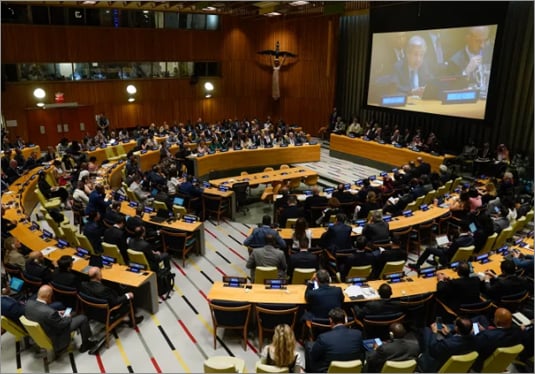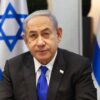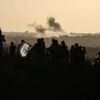The New York Declaration on the peace process and the implementation of the two-state solution aimed to revive global momentum behind the two-state framework and to halt the war on the Gaza Strip (GS). However, it also raised doubts about its practical feasibility on the ground and its ability to overcome the obstacles that have blocked progress since the Oslo Accords were signed 32 years ago. While the declaration seeks to rally broad international support for the initiative, it offers concessions that many Palestinians see as unjustified, particularly those concerning the resistance and its legitimate right to an active role in shaping Palestinian decision-making, free from imposed frameworks or external dictates.
The international conference held under the auspices of the United Nations (UN) and sponsored by France and Saudi Arabia took place from 28 to 30 July 2025. It established eight working groups tasked with developing proposals and draft resolutions on the political, economic, security and financial dimensions of the two-state solution. The conference concluded with the issuance of the New York Declaration, with the participation of Saudi Arabia, France, and 15 other countries that chaired the working groups (Brazil, Canada, Egypt, Indonesia, Ireland, Italy, Japan, Jordan, Mexico, Norway, Qatar, Senegal, Spain, Türkiye, and the United Kingdom) alongside the European Union (EU) and the League of Arab States (LAS).
On the sidelines of the conference, the French Foreign Minister announced that 15 European countries intend to recognize the State of Palestine, and called on others to follow suit. Among them are nine countries that have not yet granted recognition but have expressed readiness or interest in doing so.
Positive Indicators:
The declaration carried several positive indicators, most notably:
1. A strong international effort is underway to push for a two-state solution and the establishment of an independent Palestinian state based on the pre-June 1967 armistice lines. Regardless of the author’s personal stance on the two-state solution, this global mobilization could increase pressure on Israel, which has long abandoned this option and instead pursued a plan to erase the Palestine issue altogether through a “Decisive Plan” aimed at annexing and Judaizing what remains of the occupied Palestinian territories. Israel has also increasingly adopted ideas like “peace for peace” or even “peace by force”!!
2. For the first time, many European countries and traditional allies of Israel, such as France, the UK, Germany, Canada and Australia… have joined the effort to recognize the State of Palestine and implement the two-state solution. This development imposes further international isolation and pressure on Israel.
3. Rejecting Israel’s aggression on GS and condemning its attacks on civilians, the declaration called for an immediate end to the war, the entry of humanitarian aid, and the rejection of forced displacement and starvation policies. It also demanded reconstruction, the resumption of essential services such as electricity, water and fuel, and affirmed the role of the United Nations Relief and Works Agency for Palestine Refugees (UNRWA), thereby undermining a significant part of Israel’s plan for the Strip.
4. Demonstrating a degree of seriousness toward implementing the two-state solution by forming working committees to address political, economic, security and financial details, and by working toward a clearly defined timeline that leads to a final Israeli-Palestinian agreement.
5. Reaffirming the status of Jerusalem must not be compromised; affirming the Hashemite custodianship; reiterating that GS is an integral part of the Palestinian state; strengthening the Palestinian economy; and calling on Israel to release withheld tax revenues.
The key observation about these positive indicators is that they do not introduce anything new. They reflect the longstanding position held by most countries regarding the Palestine issue for decades. In essence, they summarize the content of hundreds of UN resolutions passed by overwhelming majorities over the past 55 years. Still, they may signal an effort to revive a spirit of initiative in the face of the realities imposed by Israel.
The international system backing the peace process had previously established political, economic, security and refugee-related working groups following the Oslo Accords, but these efforts yielded no tangible results. Likewise, a “Road Map” for establishing a Palestinian state was adopted in 2003 with a two-year timeline, yet it ultimately failed despite US sponsorship.
Several of Israel’s allied states have appeared to try to “save” it from itself, recognizing that the extremist and arrogant conduct of its government risked igniting regional anger and instability; dynamics that could ultimately pose an existential threat to Israel’s own survival.
A Peace Process Designed to Fail:
Once again, the New York Declaration offers a “car without wheels,” avoiding direct engagement with the core issue that derailed the Oslo Accords and the peace process. After 32 years, there is broad international consensus that Israel disrupted the agreements, using the peace process as a cover for intensified Judaization, settlement expansion, and the imposition of facts on the ground, ultimately making a two-state solution impossible. It has positioned itself as a “state above the law,” protected by US backing. The New York Declaration offers no serious mechanisms or guarantees to enforce the will of the international community or its resolutions (now numbering over 950) on Israel. Its demands of Israel remain in the realm of appeals, wishes and hopeful language. There are no sanctions, nor even the threat of meaningful penalties, to compel compliance. As such, the Declaration amounts to a rebranding of the failed Oslo track and a reproduction of its shortcomings. It grants Israel more time to advance its Judaization agenda, while subjecting the Palestinian side to detailed and rigid mechanisms that serve Israeli interests and reinforce the functional role of the Palestinian Authority (PA) in servicing the occupation.
Condemning Hamas and Disarming the Resistance:
For the first time, Arab and Muslim states have officially condemned Operation al-Aqsa Flood of October 7th in an official document, describing it as a deliberate targeting of civilians, echoing the Israeli narrative that Hamas has consistently denied. In contrast, the majority of Palestinians, Arabs and Muslims regarded the operation as a legitimate, heroic act and an unprecedented historic achievement. This marks a troubling shift, as these states had previously rejected any international condemnation of the operation.
The most dangerous aspect of the issue lies in the demand for Hamas to disarm and hand over its weapons to the PA, an Israeli objective at the core of its war on GS. This is a unilateral measure that effectively grants Israel full freedom to persist, consolidate and expand its Judaization and settlement projects without resistance, and to continue erasing the Palestine issue, as is happening in Jerusalem and the West Bank (WB). All this is unfolding in an Arab and international environment that openly admits its complete inability to compel Israel to abide by anything.
Thus, rather than supporting the Palestinian side in defending itself as a victim under Israeli occupation, the aggressor “Israel,” responsible for thousands of massacres, is being rewarded and its actions facilitated!! Meanwhile, there are no provisions for disarming Israel or imposing any form of international ban on it.
Removing Hamas From the Political Scene and Deepening the Schism:
The New York Declaration presents a vision that exacerbates the internal Palestinian crisis rather than resolving it. It attempts to “fabricate a distorted portrayal” of the Palestinian people’s will by conditioning elections in the WB and GS on the participation of only those Palestinians committed to the Oslo peace process and the obligations undertaken by the Palestine Liberation Organization (PLO) leadership. Practically, this means excluding Hamas, the Islamic Jihad Movement in Palestine (PIJ), and resistance factions rejecting the Oslo Accords from the electoral process, resulting in a “fabricated Palestinian legitimacy.” This comes despite all public opinion polls indicating that resistance forces enjoy greater popular support than the factions endorsing the peace process. Moreover, all Palestinian agreements over the past twenty years emphasize full partnership of all Palestinian factions in elections for the PA, the Palestinian National Council (PNC), and the reconstruction of the PLO.
This proposal aligns with the Israeli-US and international Quartet’s conditions, which have proven to be failures. It also reflects the positions of Mahmud ‘Abbas and the Fatah leadership, who recognize their inability to compete in any transparent democratic elections against Hamas and the resistance forces.
One of the clauses adds salt to the wound by calling for specific sanctions against entities and individuals working against the principle of the peace process on the Palestine issue. Of course, these measures will not target the Israeli parties that have long worked to undermine and derail this process; instead, they will be used to pursue Palestinian resistance forces who exercise their natural and legitimate right to resist Israel and to liberate their land from Israeli occupation!!
A Demilitarized Palestinian State:
The New York Declaration marks a serious concession in the framework of an independent Palestinian state by proposing a state without a military or one that is demilitarized. Rather than securing guarantees that would enable this state to defend itself against occupation, aggression and Israeli colonialism, it instead offers assurances to the occupying colonial power that systematically commits massacres, confiscates land and seizes holy sites. It provides Israel with tools to continue its expansion, impose its dominance, and reoccupy at will, based on any interpretation it considers favorable to its interests.
Integrating Israel into the Region:
The New York Declaration aims to reward Israel through a normalization program that facilitates its “integration” into the region. This narrative sidelines accountability for Israel’s crimes, its ongoing aggression against Lebanon and Syria, its attacks on Iran, and its efforts to impose security dominance across the region.
***
Finally, the international community must stop reassuring the Israeli occupation and offering it incentives, while punishing the victims and demanding further concessions and guarantees from them. It must also cease imposing its superior vision and will regarding the legitimacy and leadership of the Palestinian people. The Palestinian people are mature enough to choose their own leadership and make their own decisions. If the international community is truly serious about supporting the establishment of a Palestinian state on the territory occupied in 1967, its primary effort must be focused on compelling Israel to withdraw, not on subjecting the oppressed Palestinian people to the occupation’s standards, nor on rewarding Israel with further normalization or providing it with elements of stability and prosperity before it withdraws.
By: Prof. Dr. Mohsen Mohammad Saleh.
Source: Al-zaytouna Centre





